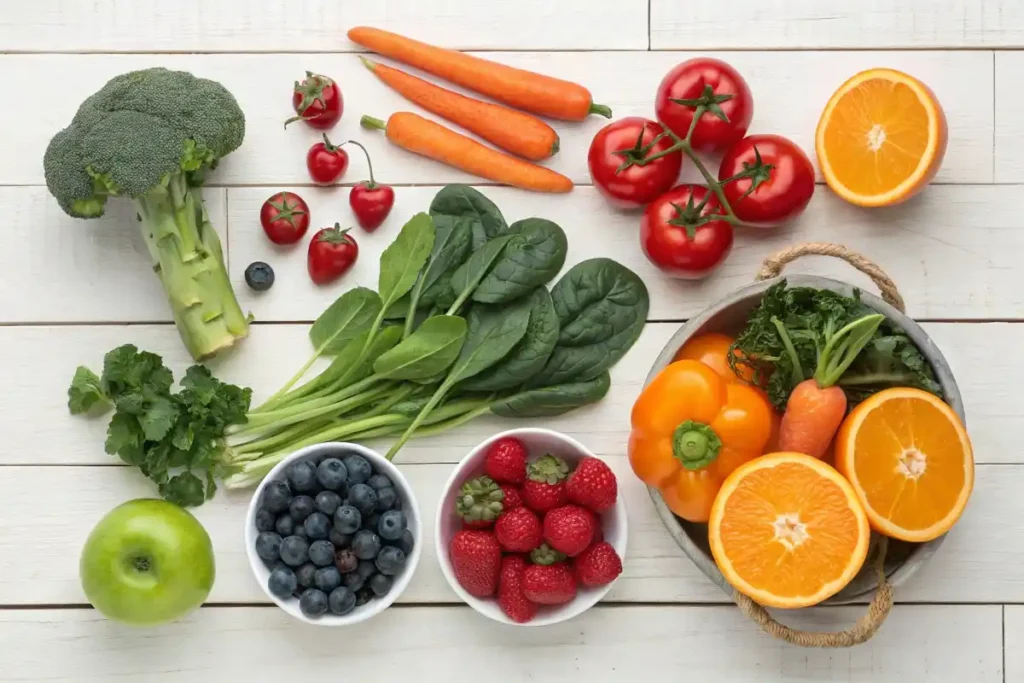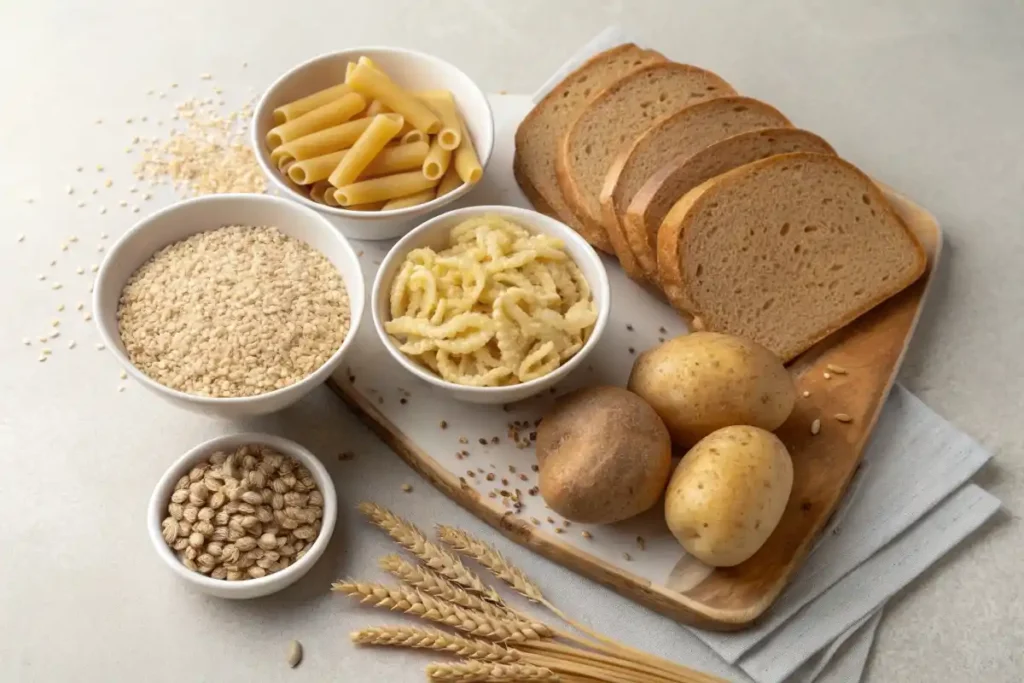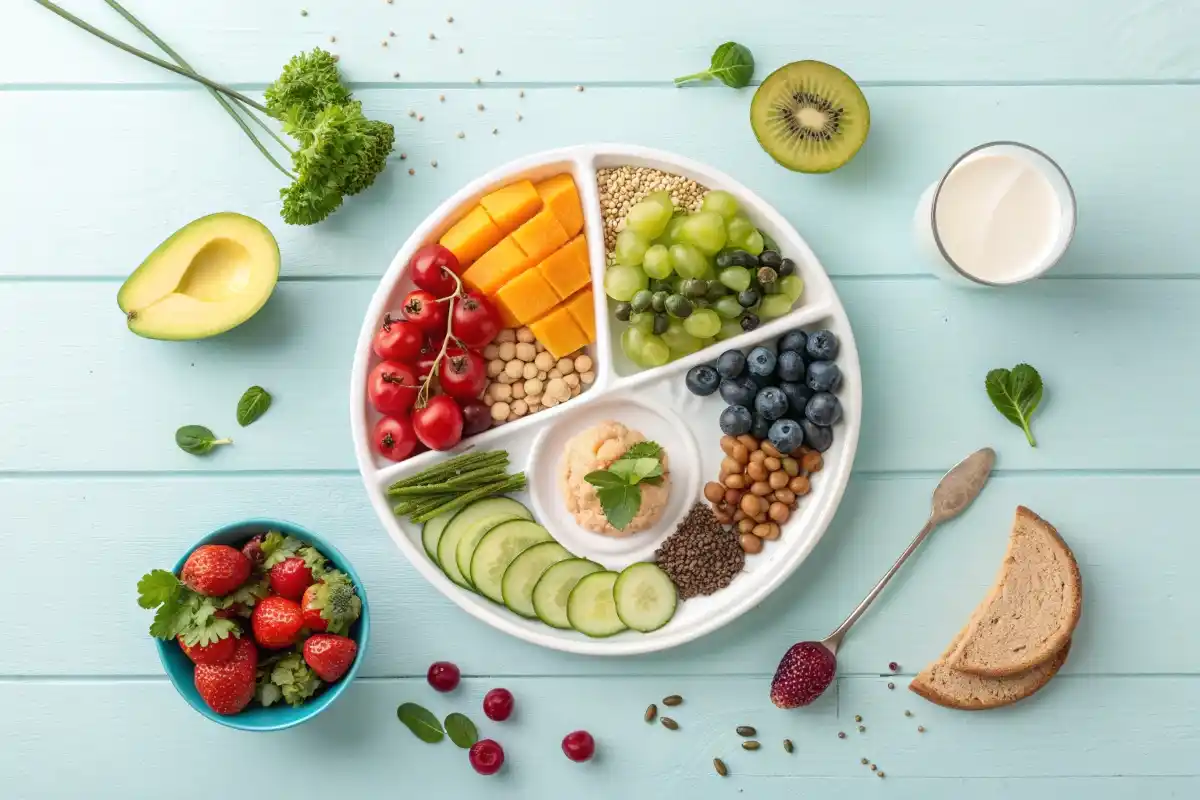Hi if you’ve ever wondered how to put together a healthy plate without getting lost in rules, this piece is for you. I’ll walk you through what the Eatwell Guide actually is, what the science says, common criticisms, and a practical 7-day meal plan you can try right away. I’ll keep things simple, friendly, and backed by trustworthy sources so you and your readers can trust what you share.
Table of Contents
What is the Eatwell Guide?
The Eatwell Guide is the UK government’s official, easy-to-read visual for a balanced diet, It shows the proportions of different food groups you should aim for across a day or week not necessarily at every single meal. Think of it as a simple map to help you eat more fruit and veg, wholegrain starchy foods, moderate protein and dairy (or alternatives), and less high-fat, high-sugar foods. GOV.UK+1

Why it matters
Because healthy eating can feel complicated. The Eatwell Guide reduces nutrition into a practical picture: what percent of your overall intake should come from fruits & vegetables, starchy carbs, protein, dairy/alternatives, and small amounts of oils and sugary foods. It’s designed for the general public not for athletes, medical patients, or people with special diets and it’s used to shape public health advice in the UK. GOV.UK Assets+1
The core recommendations (the quick checklist)
- Aim for at least 5 portions of a variety of fruit & veg daily. nhs.uk
- Base meals on higher-fibre starchy carbs (wholegrain bread, brown rice, oats, potatoes with skin).
- Include beans, pulses, fish, eggs, meat or other protein sources.
- Have some dairy or fortified alternatives.
- Choose unsaturated oils in small amounts and cut back on foods high in salt, sugar and saturated fat. nhs.uk
What the research says short, evidence-based summary
The Eatwell Guide wasn’t created from a single experiment, Instead, researchers used dietary modelling to design a recommended pattern that meets nutrient needs while staying reasonably close to what people already eat. That modelling work (for example, Scarborough and colleagues) was a major input into the Guide’s design. PMC+1
Several follow-up analyses looked at what would happen to health and the environment if populations shifted toward an Eatwell-style diet. These studies modelled potential reductions in cardiovascular disease, some cancers, and diabetes, and also showed lower dietary greenhouse-gas footprints compared with average diets meaning the Guide can support both health and sustainability goals. PLOS+2PMC+2
Bottom line from the evidence: The Eatwell Guide is a public-health tool grounded in modelling and population studies. It’s not a clinical prescription, but higher adherence is associated (in models and observational data) with better health outcomes and lower environmental impact. PLOS+1
Main criticisms and limits (what reasonable people argue)
No guideline is perfect. Here are the main concerns people raise and the context:

- Emphasis on starchy carbs. Some critics say the Guide gives a big slice of the plate to starchy carbohydrates and worry this may not fit low-carb approaches or individual needs. Supporters respond that wholegrain starchy carbs are major fibre sources and more acceptable to the population. Contract Catering Magazine+1
- Model-based, not trial-based. The Guide relies heavily on nutritional modelling rather than large randomized trials testing an Eatwell diet specifically. That’s common for national guidance, but it means the recommendations are population-level suggestions rather than guaranteed individual outcomes. PMC+1
- Questions about industry input. Some journalists and observers noted that industry groups were involved in advisory groups during the Guide’s update, prompting debate about potential conflicts of interest, Public bodies responded that evidence and expert review were central to the process. The Independent+1
- Communication and personalisation. Researchers say the Guide could communicate better for different groups (young people, different cultures, budgets), and tools to personalise guidance would help adoption. This is a communication challenge, not a contradiction of the underlying nutrition. MDPI
How I read this: The Guide is a solid, well-intentioned public-health tool. It’s best used as a starting point a friendly map and adjusted to individual medical needs, preferences, and cultural diets.
Is the Eatwell Guide right for your blog audience?
Short answer: Yes — especially if your audience is English-speaking and includes UK or European readers. It’s an authoritative, evergreen topic that signals credibility because it links to official sources (NHS / GOV.UK). If most readers are in the US, frame it as a comparative piece (Eatwell vs MyPlate) for broader appeal. Use E-E-A-T best practices: author byline, brief credentials or reviewer note (e.g., “reviewed by an RD”), and clear citations to NHS/GOV.UK and peer-reviewed studies. nhs.uk+1
Article angle I recommend for best reach
Make the piece: “friendly explainer + practical 7-day meal plan + evidence & caveats.” That format invites clicks, helps readers act, and gives you a content pillar that’s easy to promote on social media.
Practical 7-Day Eatwell-style sample meal plan (simple & real)
This plan follows Eatwell proportions (lots of veg & wholegrain starchy carbs, regular protein, small amounts of oils/sugary foods). Portions depend on age, sex, activity and energy needs adapt as needed.
Note: If you have specific medical conditions (diabetes, kidney disease), check with a clinician or dietitian.
Day 1 — Simple and familiar
- Breakfast: Porridge made with rolled oats and semi-skimmed milk (or fortified plant milk), topped with a banana and a handful of berries.
- Snack: An apple and a small handful of unsalted nuts.
- Lunch: Wholegrain sandwich with grilled chicken, mixed leaves, cucumber, and tomato. Side: carrot sticks.
- Snack: Natural yogurt (low sugar) + a drizzle of honey.
- Dinner: Baked salmon, new potatoes (skin on), steamed broccoli + side salad (olive oil & lemon).
- Tip: Drink water through the day (6–8 glasses). nhs.uk
Day 2 — Legume boost
- Breakfast: Two slices wholegrain toast + mashed avocado + cherry tomatoes.
- Lunch: Lentil & vegetable soup with wholegrain roll.
- Dinner: Stir-fry with tofu, mixed veg, brown rice.
- Snacks: Orange; a small yogurt.
Day 3 — Fish & greens
- Breakfast: Greek yogurt with oatmeal and sliced pear.
- Lunch: Salad bowl: mixed greens, quinoa, chickpeas, roasted red peppers, dressing (olive oil).
- Dinner: Grilled mackerel, sweet potato mash, green beans.
Day 4 — Veggie comfort
- Breakfast: Smoothie: spinach, banana, oats, fortified plant milk.
- Lunch: Jacket potato with baked beans and mixed salad.
- Dinner: Wholegrain pasta with tomato & mushroom sauce, side salad, sprinkle of Parmesan.
Day 5 — Quick protein
- Breakfast: Scrambled eggs on wholegrain toast, grilled tomato.
- Lunch: Tuna salad wrap (use canned tuna in water, drained), mixed veg.
- Dinner: Chicken curry with mixed veg, served with brown rice.
Day 6 — Weekend treat (balanced)
- Breakfast: Pancakes made with wholemeal flour, served with mixed berries and a small drizzle of maple syrup.
- Lunch: Roast vegetable & halloumi salad with couscous.
- Dinner: Baked cod, new potatoes, peas.
Day 7 — Plant-forward
- Breakfast: Muesli with milk, sliced apple.
- Lunch: Falafel wrap with mixed salad and tahini.
- Dinner: Vegetable & bean chilli with brown rice.
- Snack idea (any day): Fruit, raw veg, or a small handful of seeds/nuts.
This sample keeps treats and oils small and prioritises vegetables & wholegrains — the Eatwell spirit. You can adapt portions and swaps by culture, budget, and taste. GOV.UK Assets
Practical tips to apply the Eatwell Guide in real life
- Don’t try to be perfect every meal. Aim for balance over the day or week. nhs.uk
- Make veg easy: frozen veg is nutritious, cheap, and quick.
- Swap refined carbs for wholegrain versions (brown rice, wholegrain bread). nhs.uk
- Use pulses (beans, lentils) twice a week as cheaper, sustainable protein. PMC
- Watch liquid calories: sugary drinks add up fast water is the best habit. nhs.uk
FAQs (short answers your readers will love)
Q: Is the Eatwell Guide a one size fits all plan?
No it’s a population-level guide. Use it as a starting point and adjust for energy needs, culture, or medical advice.
Does it support weight loss?
The Guide focuses on overall balance and quality. For weight loss, total calories and activity matter; many people find the Guide helpful when combined with portion awareness.
Is it suitable for vegetarians or vegans?
Yes edible protein options include beans, lentils, tofu, and fortified dairy alternatives; just plan to meet nutrients like B12 and iron if vegan.
How does it compare to MyPlate (US)?
Both are visual tools with similar goals: increase veg & fruit, balance plate components. Differences reflect national contexts and emphasis, so a comparative article can attract international readers.
Is it sustainable for the planet?
Modelling suggests an Eatwell-style diet usually has a lower environmental footprint than average diets, especially when shifting toward plant-based proteins. But sustainability also depends on food choices (season, source).
Sources
- NHS — The Eatwell Guide (official explanation). nhs.uk
- GOV.UK — The Eatwell Guide (policy tool; 2016 update). GOV.UK
- Eatwell Guide booklet (GOV.UK PDF). GOV.UK Assets
- Scarborough P., modelling the Eatwell Guide (study supporting development). PMC+1
- Cobiac L.J. et al., modelling health implications (PLOS One). PLOS
- Scheelbeek P. et al., Health impacts and environmental footprints (2020). PMC
- The Carbon Trust report on Eatwell Guide sustainability. CT Prod Storage Account P
- BMJ / commentaries and debate about evidence vs critique. British Journal of Sports Medicine
- Research on communications & evolving the Guide (MDPI review). MDPI
The Eatwell Guide remains the UK’s gold standard for balanced, sustainable nutrition.
A quick reminder:
Healthy eating doesn’t mean giving up on flavor. It’s all about balance knowing when to nourish and when to enjoy.
For a light, refreshing treat that fits perfectly into that balance, check out our recipe
Peach-Basil Cream Soda Float: A Refreshing Summer Treat with Adult & Family-Friendly Versions
